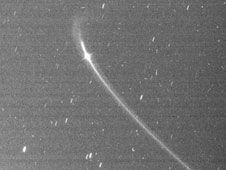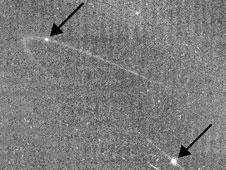Saturn's two tiny moons create arcs of material in their orbits before and after them. These arcs were recently photographed by the Cassini spacecraft

The arrows indicate the position of the moon Anthea (top left) and Methon (bottom right). Micro meteorites that crash into these moons are the source of the material you asked for.
The Cassini spacecraft, which has been orbiting the planet Saturn for about four years, recently discovered that in addition to the full rings that surround it, there are also several arcs or, if you will, partial rings that surround them together if one of the small moons and confirmed the presence of a partial ring that surrounds Saturn together with a second moon. These photographs add to the evidence that most of Saturn's small inner moons surround the planet in a complete or partial ring.
Recent photographs show material known as ring arcs, stretching before and after the small moons Anthe and Methone in their orbit around Saturn. The new findings indicate that the gravitational influence of the nearby moons or of the ring particles may be a decisive factor in whether an arc or a complete ring will form.
Both moons orbit Saturn in positions known as resonances, where the gravity of the nearby large moon Mimas interferes with their orbits. Gravitational resonances are responsible for most of the structures in Saturn's spectacular rings. Mimas provides a gravitational pull on each of these moons, causing them to bounce back and forth within an arc-like region along their orbital path. Says Nick Cooper, a Cassini imaging team member from Queen Mary University of London. "When we realized that the arc rings of Anthea and Modena are very similar to the areas where these moons move forward and backward due to the constant disturbances of Mimas, we can hypothesize the relationship of the cause and the rotator" says Cooper.

The scientists believe that the pale ring arcs of these two moons probably contain materials that were blown from the tiny moons due to the impact of micrometeorites. These materials do not spread throughout the entire orbit around Saturn and do not form a full ring, due to the gravitational disturbances of Mimas. These interactions squeeze the materials into a narrow area along the moons orbit.
This is the first time a ring of material has been observed near Anthea. The bow of Metuna was previously imaged by Cassini's magnetospheric imager, and the new image confirms its presence. Previous Cassini images revealed pale rings associated with other small moons that were embedded within or near the boundaries of Saturn's main ring system, including Phan, Janus, Epimetheus, and Phalan. Cassini previously observed an arc within the G ring, one of Saturn's fainter rings, located within the main ring system.
"This is probably the same mechanism responsible for producing the arc in the G ring," says Matthew Hedman, a member of the Cassini imaging team and a researcher at Cornell University in Ithaca, New York. Hedman and his colleagues discovered that the arc in the G ring is maintained by the gravitational resonance of Mimas, just like the two newly discovered arcs. "Actually the ring of Athena may be similar to the fragments we see in the arc of the G ring, where the large particles are clearly visible. It is conceivable that if Anthea had crashed, its fragments might have formed a complete structure like a G-ring, Hedman said.

3 תגובות
Speaking of pictures
For the editors, if you are already taking the picture from another site, then add a link if there is one to the picture in a large size, because most of the time it is impossible to understand anything from the picture
You just have to start putting smaller pictures...
And stop on these links to the original articles... it just destroys 🙂
This amazing planet Saturn